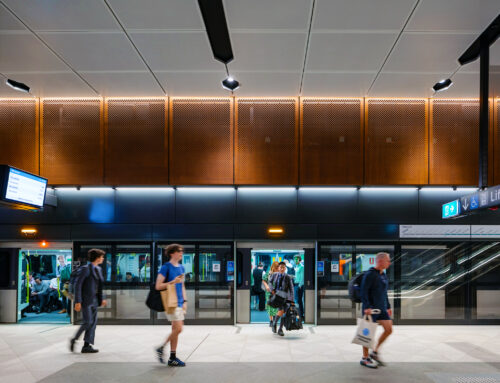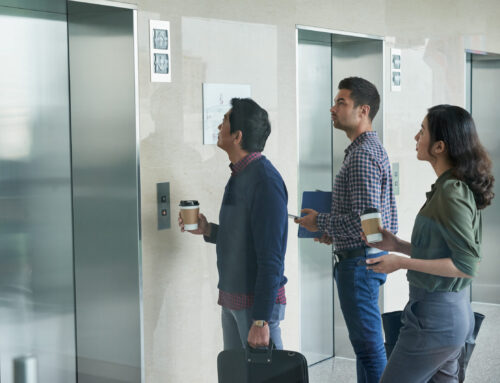It’s time for Australia to address an uncomfortable truth: we lag significantly behind global best practice in fire safety egress for mobility-impaired and disabled occupants.
Australia’s National Construction Code (NCC) is devoid of any prescriptive egress provisions for disabled individuals in emergencies, unlike many international standards. While new stadiums increasingly follow global best practice – especially in the lead-up to events like Brisbane 2032 – the rest of our built environment lags behind. Accommodation, retail precincts and public buildings are still too often designed to the bare minimum with no dedicated provisions for disabled egress.
The 2017 Grenfell Tower fire, in the United Kingdom, is a tragic example of inadequate disabled egress, among many other deficiencies. It led to 72 fatalities, including 41 per cent of the tower’s vulnerable adults. In the inquest that followed, disabled residents shared how they had no escape routes in an emergency and how many of them struggled to access their own homes when lifts were unavailable.
Just as Grenfell drove regulatory changes in relation to combustible cladding, regulatory reform should also be taken to improve disabled egress provisions within the NCC.
Current State in Australia
Part D4 of the NCC dedicates 9 pages to access provisions for people with disability. But, when it comes to escape provisions there are no equivalent prescriptive measures.
The performance requirements of the NCC include vague references to the consideration of mobility but this isn’t enforced by building certifiers or building surveyors. The reality is that the building owner or developer must decide whether they want to go beyond the bare minimum on their project.
While we encourage clients to consider this at the start of a project, few projects factor in the space and budget to go beyond minimum code compliance.
One standout example is Lendlease for having a global design standard which includes a detailed set of fire safety provisions for inclusion in their developments. This is extremely rare in the Australian market.
Personal Emergency Evacuation Plans
In the absence of prescriptive egress design measures in the NCC, the onus falls on building management or tenants to develop Personal Emergency Evacuation Plans (PEEPs). These are tailored plans for people with disabilities or mobility limitations in the event of an emergency or evacuation.
However, they do pose limitations:
- PEEPs rely on individuals identifying themselves and formally agreeing to a plan with their employer.
- They’re rarely considered during design or leasing agreements, and are normally developed after a building is completed and occupied.
- They assume the availability of trained wardens or allocated companions to provide direct assistance which may not always be practical in real-world emergencies.
- Most importantly, they’re no substitute for physical infrastructure such as refuges, communication systems or evacuation lifts that enable independent and supported egress.
A PEEP is better than nothing but it shouldn’t be our ceiling. Without supporting design measures or physical infrastructure, a PEEP is little more than an administrative process and guidance on actions to take in the event of an emergency.
If we want to move beyond administrative-based solutions like PEEPs – and create buildings that enable independent, dignified evacuation for all – we need to look to international best practice.
Case Study Examples
Independence designed in-lift evacuation strategy
International standards and guidelines increasingly support the use of evacuation lifts that remain operational during fire events, particularly in larger buildings. These lifts are essential to enabling independent evacuation, making them the most equitable solution.
We implemented this approach at Australia 108, 319 metres tall and the tallest residential building in Australia at the time. Our fire engineering and vertical transport teams developed a comprehensive strategy that included:
- dedicated evacuation lifts for disabled and mobility-impaired occupants, enabling independent evacuation
- fire and smoke-rated DDA-compliant lobbies with signage, intercoms and direct lift access
- backed-up power supply (UPS or generator) for evacuation lift operation during outages
- integration of vertical transport and emergency evacuation systems to allow fire-mode controlled operation
- warden procedures and training to prioritise and support disabled users.
We’ve implemented similar strategies in the Rod Laver Arena upgrade and Sydney Football Stadium reference design, now common in major public venues.
But, as the Paralympics roll into Brisbane in 2032, the real questions are:
- What happens outside the stadiums?
- Will our hotels, accommodation, retail spaces, public venues and transport hubs have the same safety and equitability?
Protected waiting areas – refuge areas within fire stairs
International standards also support the use of refuge areas for mobility-impaired occupants within fire stairs, particularly in buildings where evacuation lifts are not feasible. These spaces allow assisted evacuation from a protected space where full independent evacuation cannot be achieved.
We applied this approach at Sydney Metro – Crows Nest Station, Sydney, NSW, a highly complex public infrastructure. Our team delivered an integrated fire engineering strategy supported by performance-based smoke and evacuation modelling from reference design through to commissioning.
Using global standards and occupant data, we incorporated disabled refuge areas within fire stairs, sized, located and supported by communication systems to enable safer evacuation for all users.
Medal table for mobility-impaired egress design
Not all mobility-impaired egress strategies are created equal. Here’s a summary of typical approaches, from gold-standard design to the bare minimum, still commonly accepted today.
Gold
Approach – independence designed in: full equitable egress without needing assistance
Reference standards:
- Guide to Safety at Sports Grounds – Green Guide (UK)
- Accessible Stadia Guide (UK)
- ABCB Handbook – Lifts Used During Evacuation
- ISO 21542 / BS 17210
Key features:
- Two step-free egress routes from every accessible area
- Fire evacuation lifts – size and location based on expected mobility impaired population
- Refuges within fire and smoke protected lift lobbies or concourses where adequately ventilated
- Integrated communication systems
- Dynamic exit signage & multi-sensory alarms
- Staff training & evacuation planning.
Equitability: ★★★★★ Cost: $$$$
Silver
Approach – protected waiting areas: safe refuge and means of calling for assisted evacuation
Reference standards:
- BS 9999 (UK)
- BS 8300
- NFPA 101/72 (USA)
- ISO 21542 / BS 17210
Key features:
- Refuges within fire stairs or protected lobbies
- Single egress path to refuge
- Two-way intercoms to building management
- Refuge area sized for wheelchair users, located outside stair egress flow with clear access for a wheelchair user
- CCTV and lighting to refuge
- Evacuation chairs and devices
- Staff or warden response dependent.
Equitability: ★★★☆☆ Cost: $$$
Paper certificate
Approach – PEEP: administrative process with no physical infrastructure designed into the building
Reference standards:
- AS 3745
- NCC BCA (nothing prescriptive)
Key features:
- Personal Emergency Evacuation Plans (PEEPs)
- Manual evacuation devices e.g. evacuation chairs
- No refuges or emergency lift strategy
- Full reliance on others for evacuation assistance.
Equitability: ★☆☆☆☆ Cost: $
Brisbane 2032 can create a fire safety legacy for Australia
Disabled egress in Australian buildings isn’t a new conversation. The issue was debated in detail in 2015 but the cost-benefit analysis resulted in no change to the NCC. The status quo – relying on building management procedures such as PEEPs – remains unchanged.
Building owners, architects, project managers, developers and fire engineers — we can do better. This isn’t just about compliance with today’s standards, it’s about inclusion, dignity and safety for everyone who lives in, works in or moves through our buildings.
Ask the question on every project: ‘Are we designing to global best practice for disabled egress?’ That’s the only way we’re going to create the pathway for change.
Inclusive design also means designing with, not just for, people with disability. Seek input from access consultants with lived experience and across a range of impairment types.
The Brisbane 2032 Olympic and Paralympic Games are the perfect catalyst to reopen this discussion — not just for one event in one region, but for a national legacy that outlives it.
References
Australia specific
Reference: National Construction Code (NCC) – Volume One Building Code of Australia
Technical summary: Australia’s national building code including minimum access provisions (Part D4), but with no prescriptive measures for emergency egress for mobility impaired occupants. Performance requirements indirectly imply mobility requires consideration, but nothing is enforced by authorities due to absence of clear requirements.
Reference: Disability Discrimination Act 1992 (Cth)
Technical summary: Known as the DDA. Federal anti-discrimination legislation requiring equitable access to premises. While not a technical standard, the DDA may be applicable to egress where lack of provision denies safe exit for people with disabilities. This is often tested indirectly through legal interpretation, not explicit code provisions.
Reference: Australian Human Rights Commission – Guideline on Emergency Egress for People with Disability
Technical summary: Non-binding guidance promoting best practice for inclusive emergency egress in buildings. It outlines design principles and planning considerations to support equitable evacuation and is relevant when assessing potential risks of discrimination under the Disability Discrimination Act.
Reference: ABCB – Emergency Egress for Occupants with Disability
Technical summary: Discussion paper issued by the Australian Building Codes Board reviewing whether the NCC should include specific emergency egress provisions for people with disability. It explores international approaches, stakeholder feedback and cost implications. No changes were adopted at the time.
Reference: AS/NZS 3745:2010 – Planning for emergencies in facilities
Technical summary: Australian standard for emergency planning and procedures, including the preparation of Personal Emergency Evacuation Plans (PEEPs). It does not mandate physical egress infrastructure.
Reference: AS 1428.1:2021 – Design for access and mobility
Technical summary: Australian standard specifying design requirements for accessible paths of travel and spatial elements within buildings. This covers access only with no dedicated egress content.
Reference: ABCB Handbook – Lifts Used During Evacuation
Technical summary: Non-mandatory guidance published by the ABCB to support performance-based use of lifts for evacuation, addressing design considerations and technical parameters for evacuation lifts in Australian buildings.
Reference: AS/NZS 3856.1 & .2:1998 – Hoists and lifts – Evacuation chairs and devices
Technical summary: Standards specifying design and performance requirements for evacuation chairs and other assistive devices used in emergency situations.
International fire safety guidance
Reference: BS 9999:2017 – Fire safety in the design, management and use of buildings
Technical summary: UK guidance for meeting fire safety regulations through a flexible, risk-based design approach. It includes evacuation strategies, provisions for disabled refuges and associated design guidance.
Reference: NFPA 101:2021 – Life Safety Code
Technical summary: US code setting life safety design measures for buildings. Includes provisions for accessible means of egress, areas of refuge, and evacuation strategies for persons with disability.
Reference: NFPA 72:2022 – National Fire Alarm and Signaling Code
Technical summary: US code detailing the design and installation of emergency communication systems, including intercoms and alerting devices within areas of refuge.
Sector-specific guidelines
Reference: Green Guide (UK) – Guide to Safety at Sports Grounds
Technical summary: UK guide for stadium and sports ground design, including detailed requirements for accessible egress routes, evacuation lift use and step-free escape provision for all spectators. Commonly adopted in major public arena and stadium design projects internationally.
Reference: Accessible Stadia Guide (UK)
Technical summary: Supplement to the Green Guide providing additional detail on design for equitable spectator experience, including emergency evacuation for disabled occupants.
International accessibility & inclusive design standards
Reference: ISO 21542:2011 – Building construction – Accessibility and usability of the built environment
Technical summary: International standard including detailed guidance and technical requirements for access and egress features in buildings, including provisions for people with disabilities.
Reference: BS 17210:2021 – Accessibility and usability of the built environment – Functional requirements
Technical summary: UK standard aligned to ISO 21542, expanding on functional needs of users including evacuation considerations.
Reference: BS 8300-2:2018 – Design of an accessible and inclusive built environment – Part 2: Buildings
Technical summary: UK guidance on accessible design within buildings, including considerations for emergency egress routes and areas of refuge. Not a fire safety code, but supportive of inclusive design strategies.
Reference: EN 81-76:2011 – Safety rules for the construction and installation of lifts – Evacuation of disabled persons using lifts
Technical summary: European standard specifying design requirements for lifts used in emergency evacuation of mobility-impaired persons. Not directly applicable in Australia but globally recognised.
Reference: ISO 7010 – Graphical symbols – Safety colours and safety signs
Technical summary: International standard specifying safety symbols for signage including accessible egress and evacuation signs.
Industry commentary & thought leadership
Reference: Cox, R. – Universal Design: A Human Right
Technical summary: Article promoting universal design principles in emergency evacuation, arguing for built-in inclusive strategies beyond code minimums.
Reference: Wilson, L. – Refuge Areas: An Australian Experience
Technical summary: Article by Australian access consultant Lee Wilson exploring how refuge areas have been interpreted and applied in local projects. Highlights common misconceptions and the need for clearer guidance and integration within inclusive evacuation strategies.










